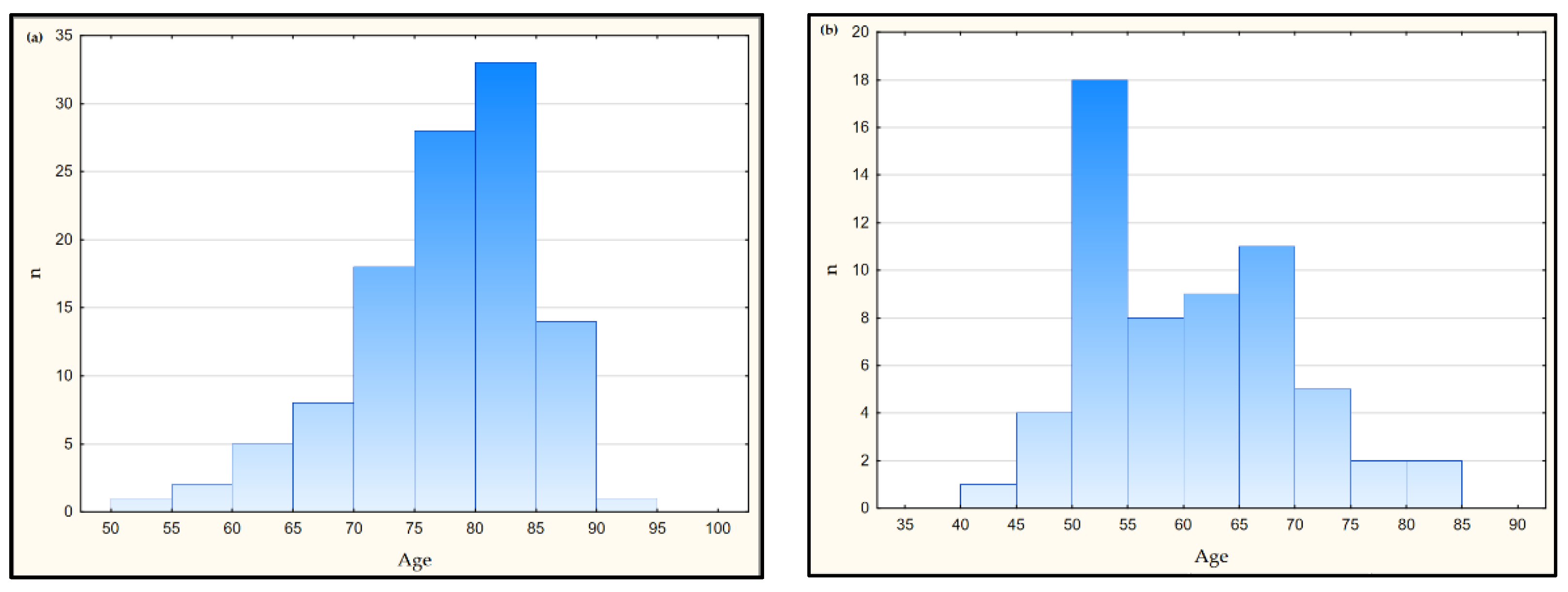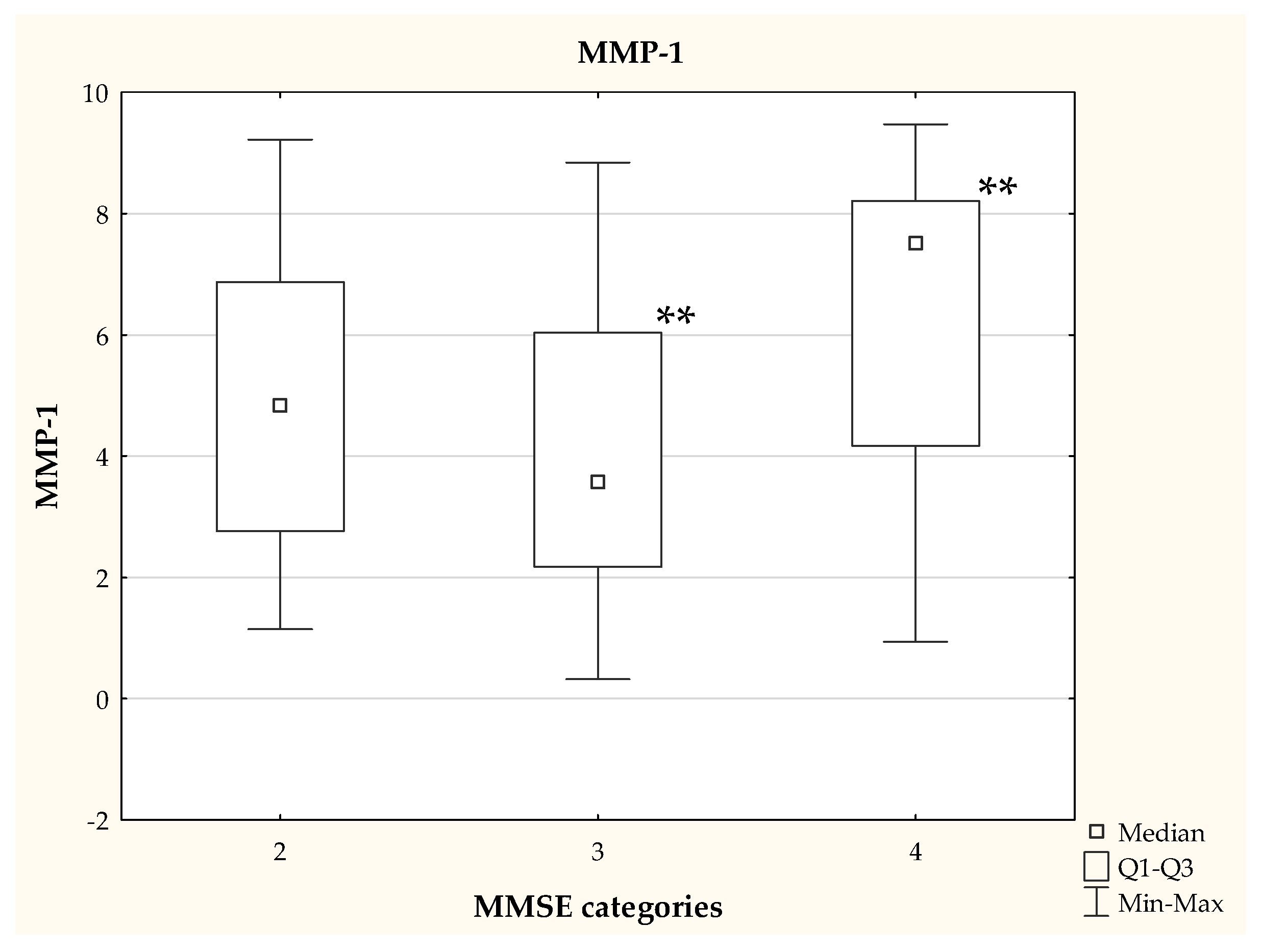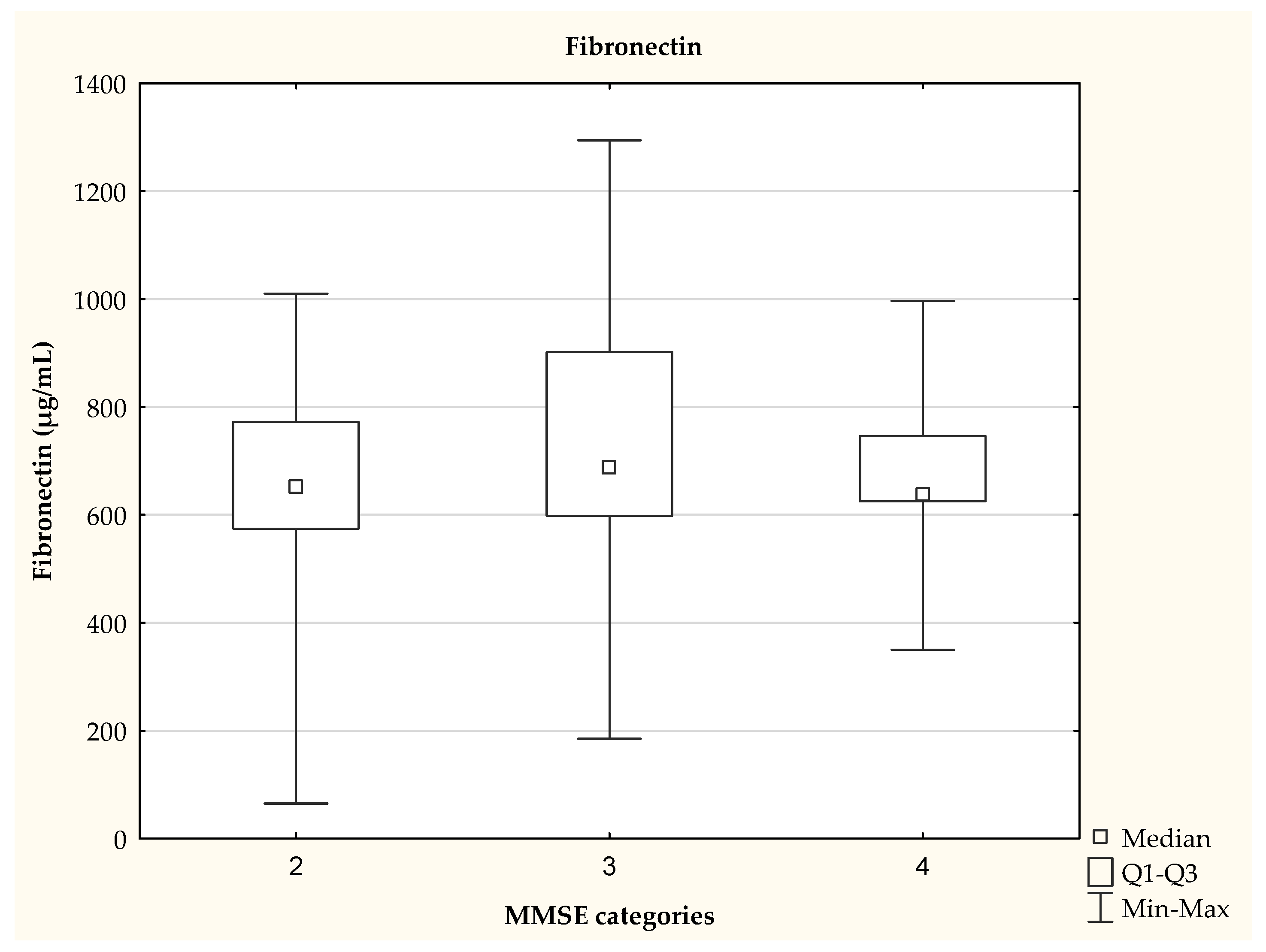The Concentration of Fibronectin and MMP-1 in Patients with Alzheimer’s Disease in Relation to the Selected Antioxidant Elements and Eating Habits
Abstract
1. Introduction
2. Materials and Methods
2.1. Characteristics of the Study Group
2.2. Food-Frequency Questionnaires (FFQ)
2.3. Collection of Blood
2.4. Determination of Fibronectin and MMP-1
2.5. Determination of Cu, Se, Zn Content and Total Antioxidant Status (TAS)
2.6. Statistical Analysis
3. Results
3.1. Concentration of Fibronectin and MMP-1
3.2. Correlations between the Parameters Studied
3.3. The Influence of Eating Habit on Fibronectin and MMP-1 Concentration
4. Discussion
5. Conclusions
Author Contributions
Funding
Institutional Review Board Statement
Informed Consent Statement
Data Availability Statement
Conflicts of Interest
References
- Glenner, G.G. Alzheimer’s disease. The commonest form of amyloidosis. Arch. Pathol. Lab. Med. 1983, 107, 281–282. [Google Scholar] [PubMed]
- Masters, C.L.; Simms, G.; Weinman, N.A.; Multhaup, G.; McDonald, B.L.; Beyreuther, K. Amyloid plaque core protein in Alzheimer disease and Down syndrome. Proc. Natl. Acad. Sci. USA 1985, 82, 4245–4249. [Google Scholar] [CrossRef] [PubMed]
- Förstl, H.; Kurz, A. Clinical features of Alzheimer’s disease. Eur. Arch. Psychiatry Clin. Neurosci. 1999, 249, 288–290. [Google Scholar] [CrossRef] [PubMed]
- Carmona, S.; Zahs, K.; Wu, E.; Dakin, K.; Bras, J.; Guerreiro, R. The role of TREM2 in Alzheimer’s disease and other neurodegenerative disorders. Lancet Neurol. 2018, 17, 721–730. [Google Scholar] [CrossRef]
- Heneka, M.T.; Carson, M.J.; El Khoury, J.; Landreth, G.E.; Brosseron, F.; Feinstein, D.L.; Jacobs, A.H.; Wyss-Coray, T.; Vitorica, J.; Ransohoff, R.M.; et al. Neuroinflammation in Alzheimer’s disease. Lancet Neurol. 2015, 14, 388–405. [Google Scholar] [CrossRef]
- Fang, X.; Zhang, J.; Roman, R.J.; Fan, F. From 1901 to 2022, how far are we from truly understanding the pathogenesis of age-related dementia? Geroscience 2022, 44, 1879–1883. [Google Scholar] [CrossRef] [PubMed]
- Bonda, D.J.; Wang, X.; Perry, G.; Nunomura, A.; Tabaton, M.; Zhu, X.; Smith, M.A. Oxidative stress in Alzheimer disease: A possibility for prevention. Neuropharmacology 2010, 59, 290–294. [Google Scholar] [CrossRef]
- Chen, K.; Lu, P.; Beeraka, N.M.; Sukocheva, O.A.; Madhunapantula, S.V.; Liu, J.; Sinelnikov, M.Y.; Nikolenko, V.N.; Bulygin, K.V.; Mikhaleva, L.M.; et al. Mitochondrial mutations and mitoepigenetics: Focus on regulation of oxidative stress-induced responses in breast cancers. Semin. Cancer Biol. 2022, 83, 556–569. [Google Scholar] [CrossRef]
- Rani, A.J.; Mythili, S.V. Study on total antioxidant status in relation to oxidative stress in type 2 diabetes mellitus. J. Clin. Diagn. Res. 2014, 8, 108–110. [Google Scholar] [CrossRef]
- Martin, H.; Lambert, M.P.; Barber, K.; Hinton, S.; Klein, W.L. Alzheimer’s-associated phospho-tau epitope in human neuroblastoma cell cultures: Up-regulation by fibronectin and laminin. Neuroscience 1995, 66, 769–779. [Google Scholar] [CrossRef]
- Ghosh, K.; Ren, X.D.; Shu, X.Z.; Prestwich, G.D.; Clark, R.A. Fibronectin functional domains coupled to hyaluronan stimulate adult human dermal fibroblast responses critical for wound healing. Tissue Eng. 2006, 12, 601–613. [Google Scholar] [CrossRef] [PubMed]
- Krzyżanowska-Gołąb, D.; Lemańska-Perek, A.; Kątnik-Prastowska, I. Fibronectin as an active component of the extracellular. matrix [in Poland: Fibronektyna jako aktywny składnik macierzy pozakomórkowej]. Postepy Hig. Med. Dosw. 2007, 61, 655–663. [Google Scholar]
- Yamada, K.M. Fibronectin peptides in cell migration and wound repair. J. Clin. Investig. 2000, 105, 1507–1509. [Google Scholar] [CrossRef] [PubMed]
- Zlokovic, B.V. Neurovascular mechanisms of Alzheimer’s neurodegeneration. Trends Neurosci. 2005, 28, 202–208. [Google Scholar] [CrossRef]
- Najjar, S.; Pearlman, D.M.; Devinsky, O.; Najjar, A.; Zagzag, D. Neurovascular unit dysfunction with blood-brain barrier hyperpermeability contributes to major depressive disorder: A review of clinical and experimental evidence. J. Neuroinflamm. 2013, 10, 142. [Google Scholar] [CrossRef]
- Wang, J.; Yin, L.; Chen, Z. New insights into the altered fibronectin matrix and extrasynaptic transmission in the aging brain. J. Clin. Gerontol. Geriatr. 2011, 2, 35–41. [Google Scholar] [CrossRef]
- Moreno-Flores, M.T.; Martín-Aparicio, E.; Salinero, O.; Wandosell, F. Fibronectin modulation by A beta amyloid peptide (25–35) in cultured astrocytes of newborn rat cortex. Neurosci. Lett. 2001, 314, 87–91. [Google Scholar] [CrossRef]
- Weremijewicz, A.; Matuszczak, E.; Sankiewicz, A.; Tylicka, M.; Komarowska, M.; Tokarzewicz, A.; Debek, W.; Gorodkiewicz, E.; Hermanowicz, A. Matrix metalloproteinase-2 and its correlation with basal membrane components laminin-5 and collagen type IV in paediatric burn patients measured with Surface Plasmon Resonance Imaging (SPRI) biosensors. Burns 2018, 44, 931–940. [Google Scholar] [CrossRef]
- Kalaria, R.N. Cerebral vessels in ageing and Alzheimer’s disease. Pharm. Ther. 1996, 72, 193–214. [Google Scholar] [CrossRef]
- Tokarzewicz, A.; Romanowicz, L.; Sveklo, I.; Gorodkiewicz, E. The development of a matrix metalloproteinase-1 biosensor based on the surface plasmon resonance imaging technique. Anal. Meth. 2016, 8, 6428–6435. [Google Scholar] [CrossRef]
- Sankiewicz, A.; Romanowicz, L.; Pyc, M.; Hermanowicz, A.; Gorodkiewicz, E. SPR imaging biosensor for the quantitation of fibronectin concentration in blood samples. J. Pharm. Biomed. Anal. 2018, 150, 1–8. [Google Scholar] [CrossRef] [PubMed]
- Dubois, B.; Feldman, H.H.; Jacova, C.; Dekosky, S.T.; Barberger-Gateau, P.; Cummings, J.; Delacourte, A.; Galasko, D.; Gauthier, S.; Jicha, G.; et al. Research criteria for the diagnosis of Alzheimer’s disease: Revising the NINCDS-ADRDA criteria. Lancet Neurol. 2007, 6, 734–746. [Google Scholar] [CrossRef]
- Socha, K.; Klimiuk, K.; Naliwajko, S.K.; Soroczyńska, J.; Puścion-Jakubik, A.; Markiewicz-Żukowska, R.; Kochanowicz, J. Dietary Habits, Selenium, Copper, Zinc and Total Antioxidant Status in Serum in Relation to Cognitive Functions of Patients with Alzheimer’s Disease. Nutrients 2021, 13, 287. [Google Scholar] [CrossRef] [PubMed]
- Gronowska-Senger, A. Methodical Guide to Dietary Research [In Polish: Przewodnik metodyczny Badan Sposobu Żywienia]. 2013. Available online: https://knozc.pan.pl/images/Przewodnik_metodyczny.pdf (accessed on 1 July 2022).
- Total Antioxidant Status (TAS). Available online: https://www.randox.com/total-antioxidant-status/ (accessed on 29 July 2022).
- Lemańska-Perek, A.; Leszek, J.; Krzyzanowska-Gołab, D.; Radzik, J.; Katnik-Prastowska, I. Molecular status of plasma fibronectin as an additional biomarker for assessment of Alzheimer’s dementia risk. Dement. Geriatr. Cogn. Disord. 2009, 28, 338–342. [Google Scholar] [CrossRef]
- Lepelletier, F.X.; Mann, D.M.; Robinson, A.C.; Pinteaux, E.; Boutin, H. Early changes in extracellular matrix in Alzheimer’s disease. Neuropathol. Appl. Neurobiol. 2017, 43, 167–182. [Google Scholar] [CrossRef]
- Erhardt, E.B.; Adair, J.C.; Knoefel, J.E.; Caprihan, A.; Prestopnik, J.; Thompson, J.; Hobson, S.; Siegel, D.; Rosenberg, G.A. Inflammatory Biomarkers Aid in Diagnosis of Dementia. Front. Aging Neurosci. 2021, 13, 717344. [Google Scholar] [CrossRef]
- Wang, X.X.; Tan, M.S.; Yu, J.T.; Tan, L. Matrix metalloproteinases and their multiple roles in Alzheimer’s disease. Biomed. Res. Int. 2014, 2014, 908636. [Google Scholar] [CrossRef]
- Lorenzl, S.; Buerger, K.; Hampel, H.; Beal, M.F. Profiles of matrix metalloproteinases and their inhibitors in plasma of patients with dementia. Int. Psychogeriatr. 2008, 20, 67–76. [Google Scholar] [CrossRef]
- Johnson, R.J.; Gomez-Pinilla, F.; Nagel, M.; Nakagawa, T.; Rodriguez-Iturbe, B.; Sanchez-Lozada, L.G.; Tolan, D.R.; Lanaspa, M.A. Cerebral Fructose Metabolism as a Potential Mechanism Driving Alzheimer’s Disease. Front. Aging Neurosci. 2020, 12, 560865. [Google Scholar] [CrossRef]
- Zhang, H.; Greenwood, D.C.; Risch, H.A.; Bunce, D.; Hardie, L.J.; Cade, J.E. Meat consumption and risk of incident dementia: Cohort study of 493,888 UK Biobank participants. Am. J. Clin. Nutr. 2021, 114, 175–184. [Google Scholar] [CrossRef]
- Cardoso, R.B.; Machado, P.; Steele, E.M. Association between ultra-processed food consumption and cognitive performance in US older adults: A cross-sectional analysis of the NHANES 2011-2014. Eur. J. Nutr. 2022, 61, 3975–3985. [Google Scholar] [CrossRef] [PubMed]
- Wang, Y.; Lebwohl, B.; Mehta, R.; Cao, Y.; Green, P.H.R.; Grodstein, F.; Jovani, M.; Lochhead, P.; Okereke, O.I.; Sampson, L.; et al. Long-term Intake of Gluten and Cognitive Function Among US Women. JAMA Netw. Open 2021, 4, e2113020. [Google Scholar] [CrossRef] [PubMed]
- Jonsson, A.; Falk, P.; Angenete, E.; Hjalmarsson, C.; Ivarsson, M.L. Plasma MMP-1 Expression as a Prognostic Factor in Colon Cancer. J. Surg. Res. 2021, 266, 254–260. [Google Scholar] [CrossRef] [PubMed]
- Kostov, K.; Blazhev, A. Changes in Serum Levels of Matrix Metalloproteinase-1 and Tissue Inhibitor of Metalloproteinases-1 in Patients with Essential Hypertension. Bioengineering 2022, 9, 119. [Google Scholar] [CrossRef] [PubMed]
- Kim, H.; Liu, X.; Kohyama, T.; Kobayashi, T.; Conner, H.; Abe, S.; Fang, Q.; Wen, F.Q.; Rennard, S.I. Cigarette smoke stimulates MMP-1 production by human lung fibroblasts through the ERK1/2 pathway. COPD 2004, 1, 13–23. [Google Scholar] [CrossRef] [PubMed]
- Logvinov, S.V.; Naryzhnaya, N.V.; Kurbatov, B.K.; Gorbunov, A.S.; Birulina, Y.G.; Maslov, L.L.; Oeltgen, P.R. High carbohydrate high fat diet causes arterial hypertension and histological changes in the aortic wall in aged rats: The involvement of connective tissue growth factors and fibronectin. Exp. Gerontol. 2021, 154, 111543. [Google Scholar] [CrossRef]



| Parameter | Study Group Av. ± SD Min–Max (n = 110) | Control Group Av. ± SD Min–Max (n = 60) |
|---|---|---|
| Age | 77.8 ± 7.6 54.0–93.0 | 57.0 ± 7.9 42.0–83.0 |
| BMI | 26.44 ± 4.13 17.78–40.23 | nd |
| MMSE | 20.4 ± 4.3 11–26 | nd |
| Parameter (Units) | Study Group Av. ± SD Min–Max Med. (Q1–Q3) | Control Group Av. ± SD Min–Max Med. (Q1–Q3) | p-Value |
|---|---|---|---|
| Fibronectin (µg/mL) | 687.99 ± 225.08 64.82–1294.13 652.06 (586.43–893.93) | 252.29 ± 60.77 62.44–334.31 268.31 (199.71–295.19) | <0.00001 |
| MMP-1 (ng/mL) | 4.86 ± 2.68 0.32–9.47 4.62 (2.50–7.47) | 17.49 ± 3.32 11.61–25.35 18.09 (15.47–19.09) | <0.00001 |
| Study Group | Control Group | |
|---|---|---|
| Parameter 1 & Parameter 2 | R (p-Value) | R (p-Value) |
| MMP-1 & Cu | −0.35 (0.0002) | ns |
| MMP-1 & Se | −0.40 (0.00002) | ns |
| MMP-1 & Zn | −0.22 (0.02) | ns |
| MMP-1 & MMSE | 0.23 (0.03) | ns |
| MMP-1 & TAS | 0.20 (0.04) | ns |
| Fibronectin & age | ns | 0.42 (0.005) |
| Independent Variables | β Coefficient (SE) | Significance Level | Adjusted R2 |
|---|---|---|---|
| Fibronectin | |||
| Fruit | 0.369 (0.133) | 0.008 | 0.28 |
| Flour dishes | 0.264 (0.126) | 0.041 | |
| White bread | −0.289 (0.137) | 0.041 | |
| Meat | 0.241 (0.129) | ns | |
| Luxurious meats | 0.239 (0.129) | ns | |
| Yellow and processed cheeses | 0.188 (0.123) | ns | |
| Fresh fish | 0.174 (0.122) | ns | |
| Wholemeal bread | −0.231 (0.146) | ns | |
| Sausages | −0.210 (0.123) | ns | |
| Poultry | −0.181 (0.133) | ns | |
| Potatoes | −0.178 (0.130) | ns | |
| Cold cuts | −0.174 (0.125) | ns | |
| White cheese | −0.135 (0.126) | ns | |
| MMP-1 | |||
| Groats, rice | 0.350 (0.112) | 0.002848 | 0.25 |
| Wholemeal bread | −0.424 (0.131) | 0.002031 | |
| White bread | −0.308 (0.127) | 0.018732 | |
| Fruit | 0.231 (0.117) | ns | |
| Sausages | 0.200 (0.113) | ns | |
| Sweet bread | −0.220 (0.110) | ns | |
| White cheese | −0.202 (0.113) | ns | |
Publisher’s Note: MDPI stays neutral with regard to jurisdictional claims in published maps and institutional affiliations. |
© 2022 by the authors. Licensee MDPI, Basel, Switzerland. This article is an open access article distributed under the terms and conditions of the Creative Commons Attribution (CC BY) license (https://creativecommons.org/licenses/by/4.0/).
Share and Cite
Bogdan, S.; Puścion-Jakubik, A.; Klimiuk, K.; Socha, K.; Kochanowicz, J.; Gorodkiewicz, E. The Concentration of Fibronectin and MMP-1 in Patients with Alzheimer’s Disease in Relation to the Selected Antioxidant Elements and Eating Habits. J. Clin. Med. 2022, 11, 6360. https://doi.org/10.3390/jcm11216360
Bogdan S, Puścion-Jakubik A, Klimiuk K, Socha K, Kochanowicz J, Gorodkiewicz E. The Concentration of Fibronectin and MMP-1 in Patients with Alzheimer’s Disease in Relation to the Selected Antioxidant Elements and Eating Habits. Journal of Clinical Medicine. 2022; 11(21):6360. https://doi.org/10.3390/jcm11216360
Chicago/Turabian StyleBogdan, Sylwia, Anna Puścion-Jakubik, Katarzyna Klimiuk, Katarzyna Socha, Jan Kochanowicz, and Ewa Gorodkiewicz. 2022. "The Concentration of Fibronectin and MMP-1 in Patients with Alzheimer’s Disease in Relation to the Selected Antioxidant Elements and Eating Habits" Journal of Clinical Medicine 11, no. 21: 6360. https://doi.org/10.3390/jcm11216360
APA StyleBogdan, S., Puścion-Jakubik, A., Klimiuk, K., Socha, K., Kochanowicz, J., & Gorodkiewicz, E. (2022). The Concentration of Fibronectin and MMP-1 in Patients with Alzheimer’s Disease in Relation to the Selected Antioxidant Elements and Eating Habits. Journal of Clinical Medicine, 11(21), 6360. https://doi.org/10.3390/jcm11216360








